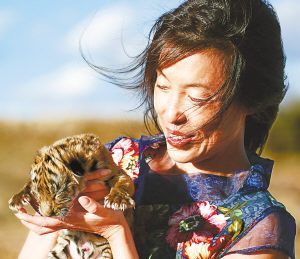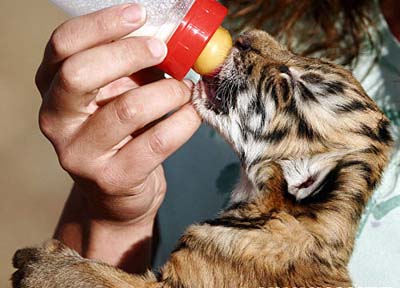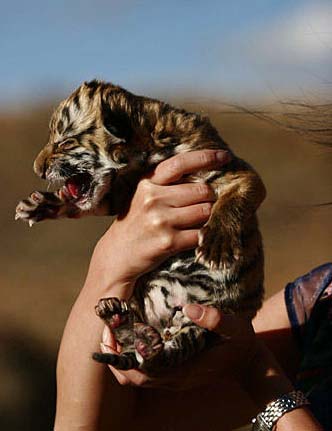A male South China Tiger cub was born at Laohu Valley Reserve about 600 km south of Johannesburg at 23:30 local time, November 23, Save China's Tigers Foundation announced on Sunday.
Quan Li, founder of Save China's Tigers Foundation, told Xinhua via telephone that it is truly a historic event because it is the first time that a South China Tiger has been born outside China.
Quan Li, founder of Save China's Tigers Foundation, stays with the new-born South China Tiger.
She said the male South China Tiger cub is at this stage healthy and strong. He weighed 1.2 kg at birth (larger than normal), and although his eyes have not yet opened, he is already quite vocal, especially at feeding time.
He is the first cub born to the female tiger Cathay and the male tiger TigerWoods, who are both undergoing rewilding training at the Laohu Valley Reserve in South Africa.
The tigers mated continuously for five days from August 7 to 11 in the 4-ha tiger camp. The frequency of the mating culminated in nine times in an hour.
As a result the female tiger was pregnant and the entire pregnancy has lasted for 103 day, according to the foundation.
After the birth, which took 12 hours, the four and a half year- old Cathay displayed her motherly instincts by cleaning and licking her cub, but unfortunately unseasonably cold weather necessitated the cub being removed to prevent it from dying from exposure.
The male tiger, TigerWoods, is three and a half years old and weighs approximately 140 kg. During the rewilding training of the past three years, he has gained a strong body and has a mischievous personality. He has yet to see his cub.
The staff at Laohu Valley monitored Cathay for 24 hours after the birth, before releasing her back into the larger tiger enclosures. She showed no adverse signs of having her cub removed.
The cub is now being hand reared with the assistance of an expert from another wildlife sanctuary.
Plans have been made to reintroduce the cub back to his mother at a suitable time. Afterwards it will undergo the same rewilding training as the older tigers did when they came to South Africa as cubs.
"The rewilding program of these highly endangered South China Tigers has taken a major step forward with the birth of this cub," Quan Li said.
"The tigers brought to South Africa from China have now not only proven they can hunt and fend for themselves, they have also proven that cubs can be bred in a natural environment," she continued.
"This event has given new impetus to the project," she concluded.
Some major conservation groups have written off the Chinese Tiger as "functionally extinct" but Save China's Tigers, the charity which initiated and manages this project, aims to take zoo born tigers from China, rewild them and allow them to learn to hunt for themselves again and to then breed them before returning the wild off-spring back to China.
Since 2003, four tigers have undergone rewilding training at Laohu Valley Reserve. They have learnt to cope with the elements and to catch a variety of prey from wild guinea fowl and hares to blesbok.
They have learnt the necessary hunting skills using stalking and camouflage techniques. To date they have successfully hunted more than 60 blesbok, proving that their natural instinct to hunt has been awakened.
Laohu Valley Reserve covers 330 square kilometers of land in both the Free State and Northern Cape Provinces. There are more than 10 species of endemic game on the reserve including blesbok, eland, springbok, black wildebeest, zebra, ostrich, gemsbok, as well as some small predators such as jackal, caracal and African wild cat.
With the birth of this cub, the project is entering in a brand new stage. China is also doing preparation work to establish a pilot reserve for the eventual return of these rewilded tigers.
The South China Tiger rewilding project has gained remarkable support worldwide. Not only has the Chinese and South African media reported on the progress of the project, but international media has regularly reported on the project as well.
Quan said: "To show my gratitude, an open day for all media will be held at Laohu Valley Reserve for the media to meet the new cub." Media will be notified of the exact date according to the progress and health of the tiger cub.
All About South China Tiger, Wildlife protection
(Xinhua News Agency November 26, 2007)








